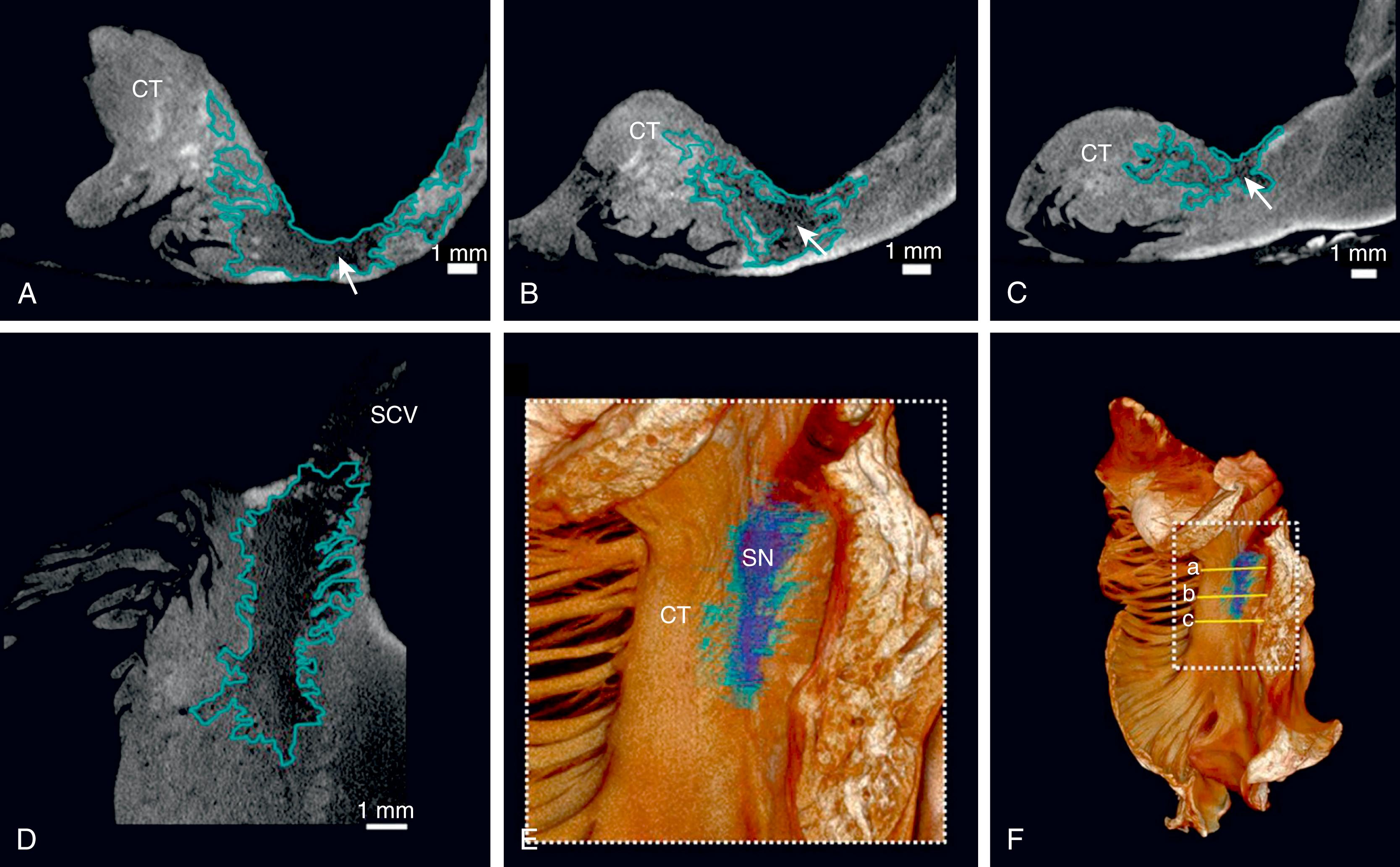Physical Address
304 North Cardinal St.
Dorchester Center, MA 02124
Although the sinus node has been recognized as the primary cardiac pacemaker for more than a century, our understanding of its complex anatomy, molecular construct, and pacemaking mechanisms remains incomplete. The cell biology of cardiac impulse initiation and propagation in regard to the sinus node are detailed in Chapter 28 . This chapter explores the anatomic and physiologic features of the sinus node, sinus node disease (SND), sinus node remodeling, familial SND, and clinical evaluation and management of SND.
The sinus node is a crescent-shaped structure that resides subepicardially with its long axis parallel to the terminal groove starting at the junction of the superior vena cava and the right atrial appendage and terminating subendocardially near the inferior vena cava. By a combination of techniques such as diffusion tensor magnetic resonance imaging (MRI) and immunohistochemistry, the sinus node measures 29.5 mm in length, 1.8 mm in height, and 6.4 mm in width. The sinus node artery often courses centrally along the length of the sinus node, but it can also be eccentric. Of note, the sinus node artery arises from the right coronary artery 55% to 60% of the time and from the left circumflex artery in the remainder. The sinus node is also well innervated with both adrenergic and cholinergic nerves, as detailed in Chapter 38 .
Both the sinus node innervation and its complex anatomy are integral to its pacemaking function. The sinus node consists of nodal cells packed in a dense connective tissue matrix. Detailed histologic examinations revealed that nodal cells are also found intermingled with ordinary atrial myocytes at the nodal periphery. Apart from nodal extensions toward the superior vena cava, subepicardium, and the terminal crest, a discrete paranodal area with loosely packed myocytes can be found in close proximity to, but not contiguous with, the sinus node. The molecular construct of this paranodal area reflects a mixture of sinus node and atrial cells with a unique makeup of ion channels, as well as intermediate cell diameter, connexin43 (Cx43), and atrial natriuretic peptide expression compared with the sinus node and atrial myocardium. This paranodal area is quite extensive with continuation toward the inferior vena cava as shown in high-resolution microcomputed tomography of the human sinus node ( Fig. 104.1 ). The relatively depolarized state of this paranodal area in comparison to the right atrium may facilitate conduction from the sinus node. Further insights regarding the sinus node can also be derived from high-resolution optical mapping studies. The sinus node appears to be insulated by conduction barriers consisting of coronary arteries and fibrous tissues, with specialized preferential conduction pathways that carry the electrical impulse to the surrounding atrium. Indeed, high-density noncontact mapping studies also demonstrated these preferential pathways of conduction between the sinus node and the atrial exit site, although none of these insulated tracts has been documented histologically. ,

Further, both the sites of sinus activation and sinoatrial exit sites have been shown to be highly variable in keeping with prior epicardial mapping study, demonstrating a widely distributed atrial pacemaker complex centered about the long axis of the sulcus terminalis. Specifically, the beat-to-beat variation in the site of sinus activation ranged from 0 to 41 mm from the superior vena cava and right atrial junction, whereas the variation in sinoatrial exit site ranged from 0 to 33 mm. It is also known that changes in heart rate, neural factors, and hormonal factors can cause a shift in both of these pacemaking and exit sites. For example, sympathetic stimulation results in a superior shift of the dominant pacemaking site and an increase in heart rate, whereas vagal activation leads to a slower but more caudal pacemaking focus. Taken together, the multicentricity of the sinus node complex, the extensive paranodal area containing both nodal and atrial tissues and the preferential conduction pathways, may all account for the high incidence of spontaneous P wave variations seen in normal individuals.
The molecular mechanisms underlying sinoatrial nodal excitability and propagation are discussed in detail in Chapter 25, Chapter 28 . SND is an abnormality in impulse generation of the sinus node resulting in a mismatch to physiologic demands. The crude incidence rate of SND is 0.8 per 1000 person-years in recent large prospective cohorts. It affects individuals of all ages with higher incidence in older individuals in their 70s and 80s, reflecting an age-related degenerative etiology. Nevertheless, myriad causes are also known to affect sinus node function ( Box 104.1 ). These include intrinsic causes, such as myocardial ischemia, nonischemic/infiltrative cardiomyopathy, surgical trauma, collagen vascular disorders, infection/inflammation, congenital heart disease, genetic disorders, and sinus node remodeling because of atrial arrhythmias, and extrinsic causes, such as drug-induced, autonomic influences, and metabolic derangements.
Become a Clinical Tree membership for Full access and enjoy Unlimited articles
If you are a member. Log in here